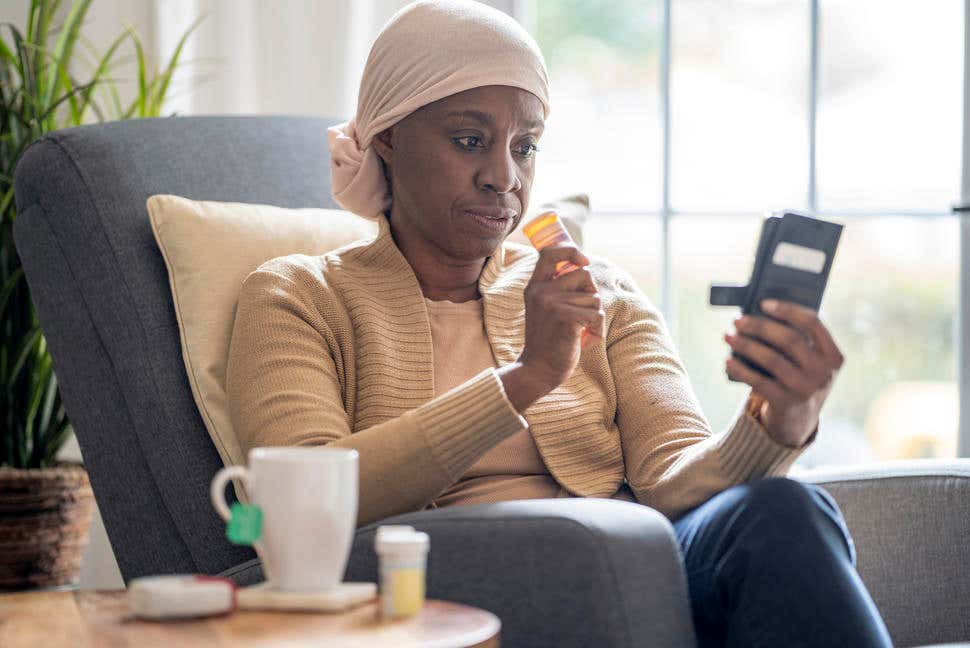Digital triage tool significantly reduces cancer treatment time
Digital triage reduces cancer treatment time by over an hour, giving patients more time for what matters most.

A text message–based triage system reduces cancer care time by over an hour per visit. (CREDIT: FatCamera / Getty Images)
Cancer patients face more than just the disease. They spend countless hours commuting, waiting, and undergoing treatment. This time burden, known as "time toxicity," is an overlooked challenge in cancer care. For many patients, each minute spent in hospitals is a minute away from loved ones, work, and activities that bring them joy.
Researchers at Penn Medicine have developed an innovative solution to reduce this time toxicity using a text message–based symptom reporting system. This pilot study suggests that digital health tools can safely streamline cancer care, giving patients precious time back.
The Burden of Time Toxicity
Time toxicity affects nearly every cancer patient. Traveling to appointments, waiting for consultations, undergoing tests, and receiving treatments all consume valuable time. For patients with advanced cancer, where time is especially precious, these delays are more than just inconveniences—they take away from meaningful life experiences.
Dr. Ronac Mamtani, section chief of Genitourinary Cancers at Penn Medicine, emphasized, “Patients with cancer spend an enormous amount of time engaging with the health care system, and for patients with advanced cancer in particular, that time is precious.”
Inspired by the fast-track efficiency of TSA PreCheck at airports, Dr. Mamtani and Dr. Erin M. Bange, now at Memorial Sloan Kettering Cancer Center, designed a mobile health platform. This system allows cancer patients to report symptoms via text message before immunotherapy infusions. If no concerning symptoms are reported and lab results are normal, patients can bypass the routine pre-treatment office visit, proceeding directly to their immunotherapy session.
The study, whose findings are published in the journal NEJM Catalyst, aimed to reduce the time toxicity of ambulatory cancer care using this text message–based electronic triage (e-triage) system. Conducted between December 2021 and December 2022, the study involved 40 adult patients with solid tumors receiving single-agent immune checkpoint inhibitors (ICIs).
Participants were randomly assigned to either the e-triage system or the usual care pathway, with the goal of comparing total time per visit, wait times, and patient satisfaction.
How Text-Based E-Triage Works
The e-triage system is simple yet effective. Patients receive a 16-question symptom check via text, which takes less than five minutes to complete. If their responses indicate no adverse symptoms and their bloodwork is normal, they can fast-track to their immunotherapy infusion without the need for an in-person pre-treatment visit.
This system was inspired by the fact that many patients receiving immunotherapy report minimal side effects compared to traditional chemotherapy. However, safety checks are still necessary before each infusion to detect any potential adverse reactions. The e-triage system allows for this safety measure to be conducted digitally, saving time without compromising patient safety.
The pilot study showed promising results. Patients who used the e-triage system spent an average of 66 minutes less per visit compared to those who followed the traditional in-person pre-treatment process. They also experienced 30 minutes less wait time per encounter. Importantly, there were no differences in emergency department visits, hospitalizations, or health-related quality of life between the two groups.
Related Stories
Real-World Impact and Patient Satisfaction
For patients battling cancer, even small reductions in time spent at medical facilities can have a significant impact on their quality of life. Dr. Bange noted, “Considering that patients who consented for the study told us that saving even 45 minutes per visit would significantly impact their lives, we were excited to see that our first test of this tool surpassed expectations, giving patients even more time back each time they went in for treatment.”
The system not only saved time but also maintained high patient satisfaction. Patients appreciated the convenience and ease of reporting symptoms from home. They felt reassured by the continuous monitoring of their health without the need for unnecessary clinic visits. This approach also provided psychological relief, allowing patients to spend more time at home, surrounded by loved ones, rather than in a hospital waiting room.
The study also highlighted the system's effectiveness in maintaining the safety of cancer care. There were no significant differences in emergency department visits or hospital admissions between patients using the e-triage system and those receiving standard care. Health-related quality of life remained consistent across both groups, demonstrating that digital symptom reporting can safely replace some in-person visits.
Challenges and Future Directions
While the e-triage system shows great promise, challenges remain. Not all patients were comfortable with the digital platform, and some preferred the reassurance of face-to-face interactions. Out of the 19 patients eligible for fast-tracking, some chose to continue with in-person visits due to personal preference or care coordination challenges.
To better understand these preferences, the researchers conducted focus groups with oncologists and patients. The feedback highlighted concerns about underreporting symptoms, difficulties in identifying eligible patients, and uncertainties about insurance reimbursement. These insights will be crucial in refining the system for wider adoption.
Dr. Mamtani explained, “Our goal is to ultimately test this strategy in a pragmatic trial, where it’s used in a real-world setting and not the controlled setting of a traditional clinical trial. But we want to be sure that we have the best-designed tool to effectively meet both provider and patient needs.”
The researchers are now working to address these concerns while maintaining the flexibility of the e-triage system. They emphasize that the system is intended as an option rather than a one-size-fits-all solution. Some patients may prefer the convenience of digital symptom reporting, while others might feel more comfortable with traditional in-person visits.
The next steps involve refining the platform to improve its usability and ensuring that it meets the needs of both patients and providers. The researchers aim to test the system in a real-world clinical setting to evaluate its effectiveness on a larger scale. If successful, this approach could be expanded to other types of cancer treatments, further reducing time toxicity and enhancing the patient experience.
A New Era in Cancer Care
The text message–based e-triage system represents a significant step forward in digital health technology, offering a practical solution to reduce time toxicity in cancer care. It empowers patients by giving them more control over their treatment schedules and more time for the things that matter most in their lives.
This pilot study demonstrates the potential of digital health tools to enhance cancer care delivery without compromising safety or quality. As the healthcare system continues to evolve, innovative solutions like e-triage are paving the way for more patient-centered care.
The promise of giving cancer patients time back—time they can spend with loved ones, pursuing hobbies, or simply living—is a powerful motivator for continued research and development.
Dr. Mamtani put it best: “Cancer patients are repeatedly asked to hurry up and wait while getting care. What we’re trying to address is just the tip of the iceberg in terms of giving patients valuable time back to focus on living.”
Note: Materials provided above by The Brighter Side of News. Content may be edited for style and length.
Like these kind of feel good stories? Get The Brighter Side of News' newsletter.
Rebecca Shavit
Science & Technology Journalist | Innovation Storyteller
Based in Los Angeles, Rebecca Shavit is a dedicated science and technology journalist who writes for The Brighter Side of News, an online publication committed to highlighting positive and transformative stories from around the world. With a passion for uncovering groundbreaking discoveries and innovations, she brings to light the scientific advancements shaping a better future. Her reporting spans a wide range of topics, from cutting-edge medical breakthroughs and artificial intelligence to green technology and space exploration. With a keen ability to translate complex concepts into engaging and accessible stories, she makes science and innovation relatable to a broad audience.



